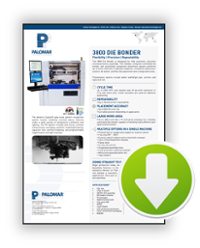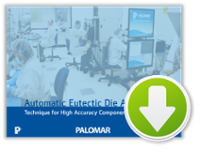In the bond cycle, an incremental thermal energy is supplied to the solder layer to promote the solder melting process. Liquefied solder then penetrates both bonding surfaces. An intermetallic bond develops, which is also known as wetting. The solder, usually precipitated to the die  foundation (backside metallization) or to the substrate surface, can also be supplied as preform solder pieces cut to a certain percentage of the die size. While preforms are a cheap solution to apply solder, their use does require an additional pick-and-place process step.
foundation (backside metallization) or to the substrate surface, can also be supplied as preform solder pieces cut to a certain percentage of the die size. While preforms are a cheap solution to apply solder, their use does require an additional pick-and-place process step.
Much of our prior work with solder die attach at Palomar Technologies has been utilizing preforms. These are now well understood and easy to specify for a reliable process. However, the lead time and cost for specific preforms can be prohibitive for new process development. Conversely, solder pastes are easy to keep on hand and the volume utilized per die can be tailored for each application.
The Challenge
The requirement for this specific application was to utilize SAC-305 solder to die attach LEDs. The options were for preforms (costly and long lead time as well as an added pick and place operation for each die) or solder paste. Preforms must be specified for each unique die (size and shape, including thickness as well as composition). Solder paste is in many cases an off-the-shelf item. For this higher volume production application it was determined solder paste would be the preferred approach with the highest throughput.
The various options for specifying solder paste presented the first challenge. The next challenge was deciding on the best process to apply the solder.
The first attempts included using a daub pot to transfer the paste from the pot to the bond site. This had little success because of the paste characteristics. The problems included the amount of flux in the paste and particle size of the solder spheres in the paste. This resulted in often too little solder and too much flux being transferred.
|
|
|
The Solution
It was quickly decided that the 3800 Die Bonder dispense option would be better suited to this process. The amount of solder placed could be more easily controlled. However, problems were encountered because of the solder particle size. Even with a large dispense tip it was difficult to properly dispense the correct amount of paste. This was likely due to the friction of the paste through the dispense needle and air trapped in the syringe. As the air bubbles neared the tip, there would be excess paste dispensed.
The problem was solved by proper selection of the maximum paste solder particle size and more care in filling the syringe to reduce the air bubbles within. The die being placed were about 1mm x 1mm and it was found that “Type 4” would provide a reliable and consistent dispense on the 3800 Die Bonder time/pressure dispense option. The “standard” particle size is “Type 3” which has particles 25 - 45 μm with 99% below 38 μm. Type 4 has particles 20 - 38 μm with 99% below 30 μm.
The Results
The results included a reliable and repeatable amount of solder placed relatively rapidly, as well as consistently bonded LEDs for the customer.
Although these results come from LED attach, they are not specific to that application. This information is valuable to all solder die attach applications.
For more on the 3800 Die Bonder, download the data sheet:
----
David Rasmussen
Assembly Services General Manager
Palomar Technologies, Inc.

